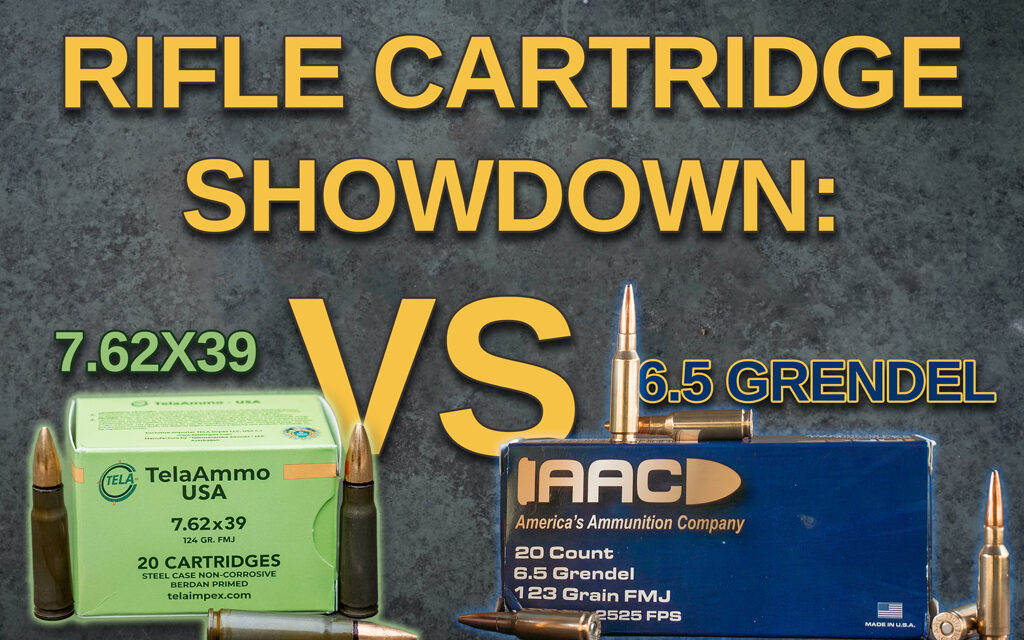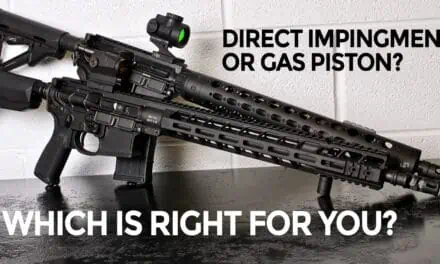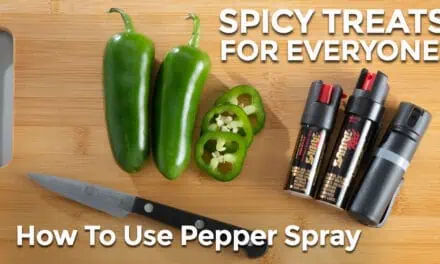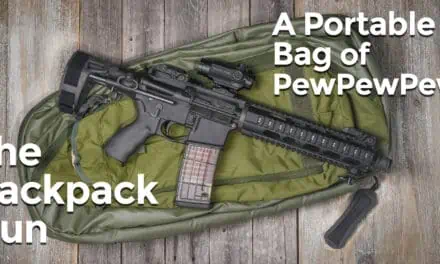7.62x39mm vs. 6.5mm Grendel
The 7.62x39mm is an intermediate cartridge developed during the mid-1940s. It was designed so that Soviets could more easily spray enemies of communism with automatic fire. Though, it has proven plenty effective at defeating the enemies of whomever happens to be holding an AK-47. The 7.62×39 is a large part of the reason why the AK-47 became the most widely manufactured rifle on earth.
The 6.5mm Grendel is also an intermediate cartridge, albeit developed much later in 2003. The American cartridge was designed to improve on the performance of the 5.56x45mm without necessitating replacement of the Armed Forces’ M4 carbine and M16 rifle. The 6.5 Grendel wasn’t adopted by the U.S. military, though it has won (deserved) popularity in our commercial market nevertheless.

Hornady SST and AAC FMJ 6.5 grendel loads.
This article doesn’t presume that a fair comparison can be drawn between two such cartridges. Despite having six additional decades’ worth of technological advancement behind it, the 6.5 Grendel cannot reasonably be described as “better” than the 7.62×39. Doing so would be like declaring a best socket wrench size: silly.
This article’s only aim is to illustrate objective differences between two popular rifle rounds. So keep reading if you’re debating purchasing one over the other for target shooting, home defense, hunting, or anything else you might use a proper semi-automatic rifle for.
7.62x39mm vs. 6.5mm Grendel: Physical Dimensions
Before we slip these cartridges off their leashes, let’s see how they fare in a literal side-by-side comparison.
| 7.62x39 | 6.5 Grendel | |
|---|---|---|
| Bullet diameter | 0.309–0.311 in | 0.264 in |
| Land diameter | 0.300 in | 0.256 in |
| Neck diameter | 0.339 in | 0.293 in |
| Shoulder diameter | 0.396 in | 0.428 in |
| Base diameter | 0.447 in | 0.439 in |
| Rim diameter | 0.447 in | 0.440 in |
| Case length | 1.524 in | 1.520 in |
| Overall length | 2.205 in | 2.260 in |
| Case capacity | 35.6 gr H2O | 35.0 gr H2O |
| Max pressure (SAAMI) | 45,010 psi | 52,000 psi |
It only makes sense that these intermediate rounds’ dimensions shouldn’t be too radically dissimilar. The most notable similarity between them are their case capacities. They are nearly identical, meaning they can (and indeed, often do) contain identical quantities of propellant.
These rounds’ most important difference are their projectiles: a classic .30 cal bullet, similar (but not identical) to what the U.S. military’s .30-06 Springfield and 7.62x51mm cartridges both have, and a narrower .264 cal bullet, which is typically loaded in commercial long-distance target and hunting cartridges such as the 6.5mm Creedmoor and 6.5 PRC.
7.62×39 vs. 6.5mm Grendel: Ballistics
Despite having different calibers, these rounds are commonly loaded with bullets of the same weight. That’s nice. It means we can observe the effects of the 6.5 Grendel’s (A) longer, narrower bullets and (B) significantly higher muzzle velocities, which it delivers courtesy of its higher chamber pressure.
In other words, we’re about to see how the 7.62×39 fares against a more powerful cartridge loaded with a more aerodynamic bullet. If you expect 6.5 Grendel bullets to fly faster – thereby giving gravity relatively less time to push them downward between point A and point B – then you won’t be surprised by what’s coming.
| Ammunition | 7.62x39 120gr Split Core HP; 24" bbl; 0.251 G1 BC | 7.62x39 123gr FMJ; 24" bbl; 0.294 G1 BC | 7.62x39 124gr FMJ; 20.5" bbl; 0.286 G1 BC | ||||||
|---|---|---|---|---|---|---|---|---|---|
| Range (yds) | Velocity (fps) | Energy (ft lbs) | Elevation (in) | Velocity (fps) | Energy (ft lbs) | Elevation (in) | Velocity (fps) | Energy (ft lbs) | Elevation (in) |
| 0 | 2365 | 1491 | -1.5 | 2461 | 1654 | -1.5 | 2421 | 1614 | -1.5 |
| 100 | 2043 | 1112 | 3.5 | 2178 | 1296 | 3.0 | 2133 | 1253 | 3.1 |
| 200 | 1749 | 815 | 0.0 | 1915 | 1001 | 0.0 | 1866 | 959 | 0.0 |
| 300 | 1489 | 591 | -14.9 | 1673 | 765 | -12.5 | 1623 | 725 | -13.1 |
| 400 | 1271 | 431 | -45.7 | 1458 | 580 | -37.5 | 1408 | 546 | -39.6 |
| 500 | 1111 | 329 | -98.0 | 1274 | 444 | -78.9 | 1230 | 417 | -83.7 |
| Ammunition | 6.5 Grendel 120gr BTHP; 24" bbl; 0.401 G1 BC | 6.5 Grendel 123gr FMJ; 24" bbl; 0.420 G1 BC | 6.5 Grendel 124gr FMJ; 23.5" bbl; 0.400 G1 BC | ||||||
| Range (yds) | Velocity (fps) | Energy (ft lbs) | Elevation (in) | Velocity (fps) | Energy (ft lbs) | Elevation (in) | Velocity (fps) | Energy (ft lbs) | Elevation (in) |
| 0 | 2674 | 1906 | -1.5 | 2580 | 1818 | -1.5 | 2576 | 1827 | -1.5 |
| 100 | 2455 | 1606 | 2.2 | 2375 | 1540 | 2.4 | 2361 | 1535 | 2.4 |
| 200 | 2246 | 1344 | 0.0 | 2179 | 1297 | 0.0 | 2156 | 1280 | 0.0 |
| 300 | 2047 | 1117 | -9.1 | 1992 | 1084 | -9.7 | 1962 | 1060 | -9.9 |
| 400 | 1860 | 922 | -26.5 | 1816 | 901 | -28.2 | 1779 | 871 | -28.8 |
| 500 | 1684 | 756 | -53.9 | 1651 | 745 | -57.2 | 1609 | 713 | -58.8 |
It’s plain to see the 6.5 Grendel is the flatter-shooting cartridge. Our three 7.62×39 comparison rounds exhibit an average drop of -86.9” at 500 yards. That’s not dreadful, but it’s also not nearly as good as the 6.5 Grendel’s -67.3” average drop at the same range.
The 7.62×39 is by no means inaccurate (see our 7.62×39 accuracy testing for more information on that note). But by being more level, the 6.5 Grendel’s trajectory does facilitate aiming across longer distances. You wouldn’t note any difference at close range, though you’d find life easier if you favored the 6.5 Grendel for shooting at ranges beyond 300 yards.
7.62x39mm vs. 6.5mm Grendel: Stopping Power
I’m guilty of many things, but staking too much importance on the concept of “stopping power” isn’t one of them. It overlooks the all-importance of shot placement. For example, a well-placed shot with a fur hunter’s .22 Short is incomparably more effective than a miss with an ivory hunter’s .500 Nitro Express.
That being said, it’s important to note which round hits harder. All other things being equal, the stronger cartridge poses the likelier chance of neutralizing the target in one shot.
The 6.5 Grendel is the stronger cartridge. Our three 6.5 Grendel comparison rounds’ average muzzle energy equals 1,850 ft lbs – about 17% higher than 7.62×39 (1,586 ft lbs).
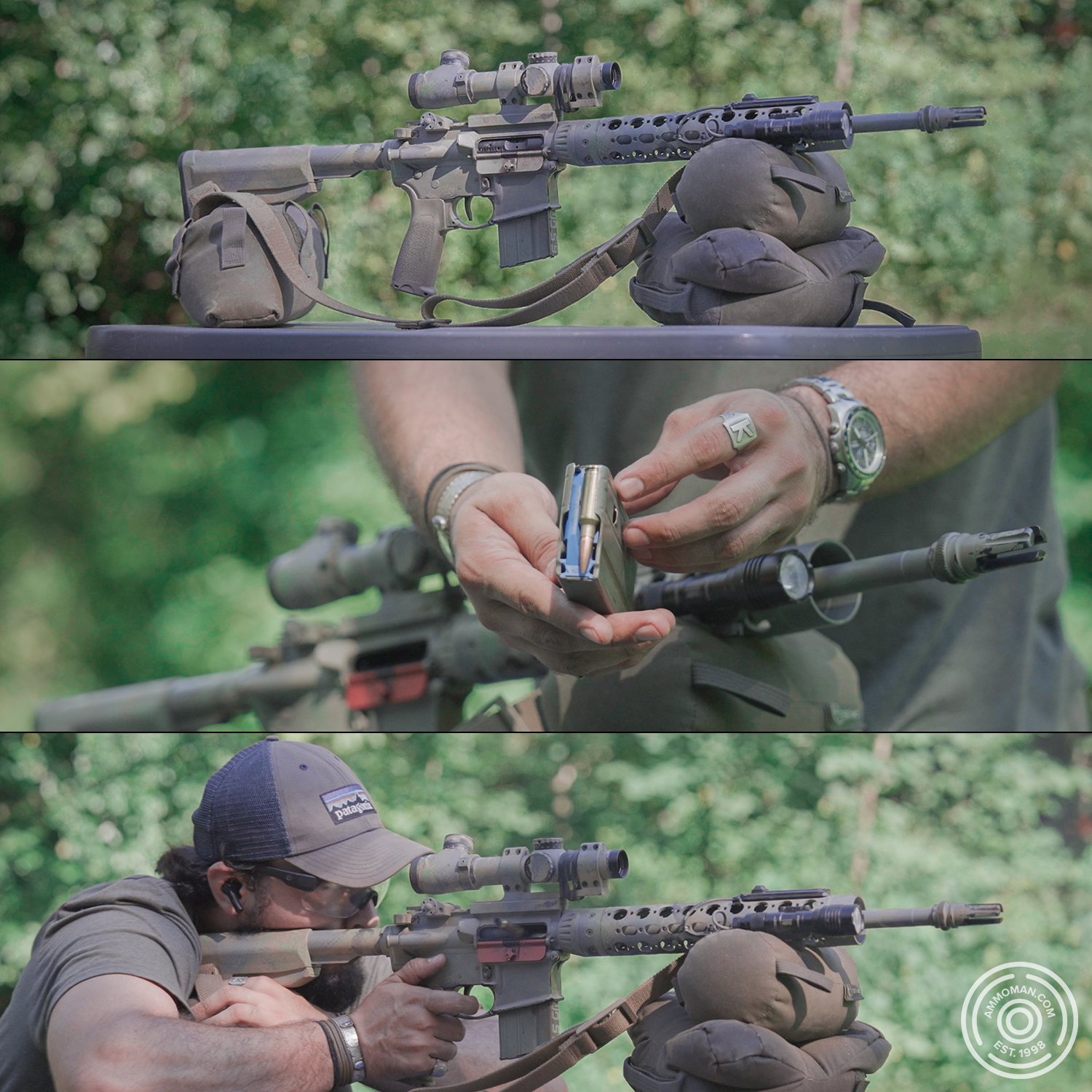
The 6.5 grendel works well in the AR platform.
The 6.5 Grendel maintains its advantage in striking energy downrange. Its faster-moving and aerodynamically superior bullet does a better job at overcoming frontal air resistance and conserving momentum. That accounts for why it hits harder at any distance. To illustrate, the 7.62×39 usually dips to triple-digit striking energy at an average of 221 yards, whereas the 6.5 Grendel does the same at 344 yards.
| Farthest Distance at Which Bullet Retains at Least 1,000 ft lbs of Energy (yds) | |
|---|---|
| 7.62x39 120gr Split Core HP | 134 |
| 7.62x39 123gr FMJ | 200 |
| 7.62x39 124gr FMJ | 330 |
| 6.5 Grendel 120gr BTHP | 358 |
| 6.5 Grendel 123gr FMJ | 344 |
| 6.5 Grendel 124gr FMJ | 330 |
Sectional density (a numeric representation of a bullet’s capacity for penetration) also has significant bearing on stopping power. Naturally, the 6.5 Grendel’s narrower, more needle-like bullet excels at stabbing through flesh. Its 120 gain bullet has a sectional density of 0.246. At the same bullet weight, the 7.62×39’s sectional density equals 0.177.
7.62x39mm vs. 6.5mm Grendel: Recoil
I won’t hit you over the head with a lengthy explanation of the virtues of low recoil. Lower recoil means greater comfort, plus less of the muzzle rise which complicates accurate, rapid fire. Less recoil is always preferable.
To that end, the 7.62×39 is the lower-recoiling cartridge. That only makes sense in light of its weaker striking power.

7.62×39 recoil
How much gentler is the 7.62×39’s recoil, exactly? That’s both difficult and easy to say. It’s difficult because the “felt” recoil you’ll actually perceive depends on multiple factors. Both the style of rifle and the immeasurable workings of your own nervous system have an impact. It’s easy because free recoil energy is determined by only four factors: muzzle velocity, firearm weight, bullet weight, and propellant weight. For the sake of this comparison let’s suppose (A) we’re firing two 8.5 lb rifles; (B) all 7.62×39 rounds have 24 grains of propellant; and (C) all 6.5 Grendel rounds have 25 grains of propellant.
| Recoil Energy (ft lbs) | |
|---|---|
| 7.62x39 120gr Split Core HP | 6.1 |
| 7.62x39 123gr FMJ | 6.7 |
| 7.62x39 124gr FMJ | 6.6 |
| 6.5 Grendel 120gr BTHP | 7.4 |
| 6.5 Grendel 123gr FMJ | 7.3 |
| 6.5 Grendel 124gr FMJ | 7.4 |
The 7.62×39 has less recoil, but not by all that much. The 6.5 Grendel’s superior long-range ballistics and terminal performance both come at the cost of just 14% higher recoil.
Take all this with a grain of salt. You may very well discern zero difference between the two rounds’ recoil. Even if you could tell them apart by touch alone, you might find yourself hard-pressed to say which round’s recoil is actually stronger.
7.62x39mm vs. 6.5mm Grendel: Availability and Cost
Expect to find 7.62×39 ammo in greater quantities and at lower prices. It’s one of the most mass-produced rifle cartridges on earth, and often offered for relatively cheap by foreign brands such as Sellier & Bellot, Prvi Partizan, Belom, and many more. Truly economical steel-cased 7.62×39 ammo also used to be abundant, but not anymore after the Biden administration banned its import.
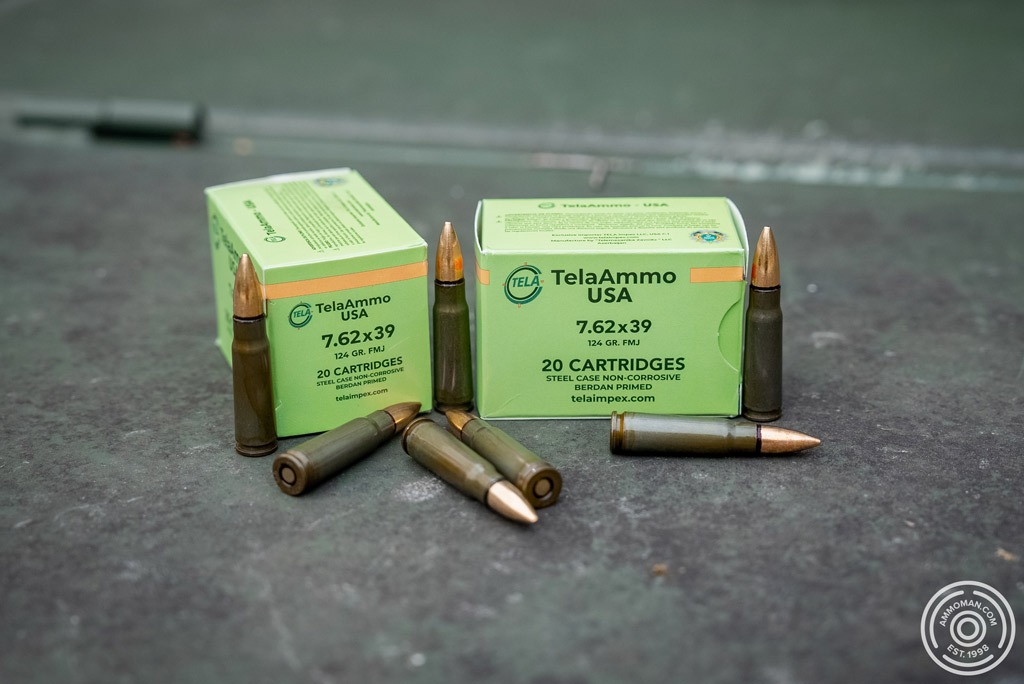
Tela steel cased 7.62×39
You’ll find a smaller selection of 6.5 Grendel ammo for sale. You’ll also pay a higher price per round. You will find that 6.5 Grendel ammo generally tends to be of higher quality, however. While both rounds are commonly loaded with conventional full metal jacket (FMJ) bullets, the 6.5 Grendel is often loaded with the expanding bullets you would want for defense or hunting (e.g. TSX, SST) or long-distance target shooting (e.g. OTM BT, ELD Match).
In fewer words, 7.62×39 ammo is cheaper, but there are a far greater variety of specialized, higher-quality 6.5 Grendel cartridges on the market.
Conclusion
The 6.5 Grendel flies flatter, hits harder, penetrates deeper, and is loaded for a wider variety of applications. The 7.62×39 recoils softer and is cheaper.
Despite having so many differences, these two rounds aren’t night and day. (It’s not like we’re pitting 5.7x28mm NATO against 120x570mm NATO here.) With a little training, you could learn to defend your home just as effectively with one as the other.
It ultimately boils down to what you’re looking for in a rifle: An AR-15 chambered for something with more “oomph” than the standard 5.56×45? Or a rugged, reliable, and fun-to shoot AK-47 (noting that other, less common 7.62×39 rifles exist, such as the SKS or Ruger Mini Thirty).
Ideal solution: Buy rifles chambered for both, and order all your ammo from this very website.

